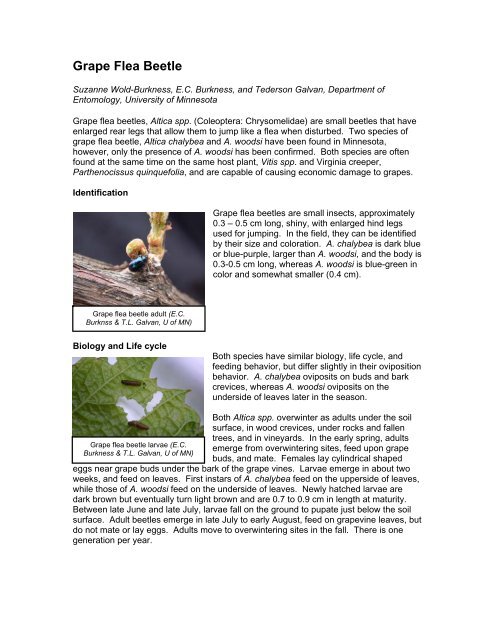Grape Flea Beetle - Commercial Fruit Production in Minnesota
Grape Flea Beetle - Commercial Fruit Production in Minnesota
Grape Flea Beetle - Commercial Fruit Production in Minnesota
Create successful ePaper yourself
Turn your PDF publications into a flip-book with our unique Google optimized e-Paper software.
<strong>Grape</strong> <strong>Flea</strong> <strong>Beetle</strong>Suzanne Wold-Burkness, E.C. Burkness, and Tederson Galvan, Department ofEntomology, University of M<strong>in</strong>nesota<strong>Grape</strong> flea beetles, Altica spp. (Coleoptera: Chrysomelidae) are small beetles that haveenlarged rear legs that allow them to jump like a flea when disturbed. Two species ofgrape flea beetle, Altica chalybea and A. woodsi have been found <strong>in</strong> M<strong>in</strong>nesota,however, only the presence of A. woodsi has been confirmed. Both species are oftenfound at the same time on the same host plant, Vitis spp. and Virg<strong>in</strong>ia creeper,Parthenocissus qu<strong>in</strong>quefolia, and are capable of caus<strong>in</strong>g economic damage to grapes.Identification<strong>Grape</strong> flea beetles are small <strong>in</strong>sects, approximately0.3 – 0.5 cm long, sh<strong>in</strong>y, with enlarged h<strong>in</strong>d legsused for jump<strong>in</strong>g. In the field, they can be identifiedby their size and coloration. A. chalybea is dark blueor blue-purple, larger than A. woodsi, and the body is0.3-0.5 cm long, whereas A. woodsi is blue-green <strong>in</strong>color and somewhat smaller (0.4 cm).<strong>Grape</strong> flea beetle adult (E.C.Burknss & T.L. Galvan, U of MN)Biology and Life cycleBoth species have similar biology, life cycle, andfeed<strong>in</strong>g behavior, but differ slightly <strong>in</strong> their ovipositionbehavior. A. chalybea oviposits on buds and barkcrevices, whereas A. woodsi oviposits on theunderside of leaves later <strong>in</strong> the season.<strong>Grape</strong> flea beetle larvae (E.C.Burkness & T.L. Galvan, U of MN)Both Altica spp. overw<strong>in</strong>ter as adults under the soilsurface, <strong>in</strong> wood crevices, under rocks and fallentrees, and <strong>in</strong> v<strong>in</strong>eyards. In the early spr<strong>in</strong>g, adultsemerge from overw<strong>in</strong>ter<strong>in</strong>g sites, feed upon grapebuds, and mate. Females lay cyl<strong>in</strong>drical shapedeggs near grape buds under the bark of the grape v<strong>in</strong>es. Larvae emerge <strong>in</strong> about twoweeks, and feed on leaves. First <strong>in</strong>stars of A. chalybea feed on the upperside of leaves,while those of A. woodsi feed on the underside of leaves. Newly hatched larvae aredark brown but eventually turn light brown and are 0.7 to 0.9 cm <strong>in</strong> length at maturity.Between late June and late July, larvae fall on the ground to pupate just below the soilsurface. Adult beetles emerge <strong>in</strong> late July to early August, feed on grapev<strong>in</strong>e leaves, butdo not mate or lay eggs. Adults move to overw<strong>in</strong>ter<strong>in</strong>g sites <strong>in</strong> the fall. There is onegeneration per year.
Damage<strong>Grape</strong> flea beetle adult on adamaged bud (T.L. Galvan & E.C.Burkness, U of MN)Damage is caused by adult beetles feed<strong>in</strong>g onprimary buds, which prevents them from develop<strong>in</strong>g<strong>in</strong>to shoots, thus result<strong>in</strong>g <strong>in</strong> a decreased yield. Thegreatest economic loss occurs when beetles feed onbuds from “bud swell” until the “first leaf separatesfrom the shoot tip” stages (see Appendix A). Onceshoot growth reaches 7 cm, damage caused by thegrape flea beetle normally does not affect yield.Location of v<strong>in</strong>es can affect the <strong>in</strong>tensity of an<strong>in</strong>festation, with v<strong>in</strong>es on the borders of the v<strong>in</strong>eyardand next to wooded areas hav<strong>in</strong>g higher <strong>in</strong>festations.In addition, weather can also affect the <strong>in</strong>tensity ofthe damage. Cooler spr<strong>in</strong>gs will extend the period ofdevelopment when buds are more susceptible to thebeetle feed<strong>in</strong>g, thus <strong>in</strong>creas<strong>in</strong>g the chance ofeconomic loss.Although primary damage is caused by adult fleabeetle to the develop<strong>in</strong>g buds, larval damage canalso occur on the foliage and is typically limited toseveral leaves and v<strong>in</strong>es. However, larval damagedoes not usually affect grape quality or yield.<strong>Grape</strong> flea beetle damage togrape bud (E.C. Burkness & T.L.Galvan, U of MN)ManagementMonitor<strong>in</strong>g<strong>Grape</strong>s should be sampled dur<strong>in</strong>g the “bud swell” to the “first-leaf separated from shoottip”stages, which is generally dur<strong>in</strong>g late April – early May. Sampl<strong>in</strong>g should be donetwice per week by check<strong>in</strong>g for damaged buds and flea beetle adults. The currentsuggested threshold is 5% damaged buds.Cultural/Physical ControlRemove debris and leaf litter on the edges of wooded areas located near v<strong>in</strong>eyards toelim<strong>in</strong>ate overw<strong>in</strong>ter<strong>in</strong>g sites. In addition, shallow disk<strong>in</strong>g the area between grape rowscan also help destroy overw<strong>in</strong>ter<strong>in</strong>g pupae.Chemical controlSeveral <strong>in</strong>secticides provide good control of grape flea beetle, and can be found <strong>in</strong> theMidwest Small <strong>Fruit</strong> Pest Management Handbook.
ReferencesBordelon, B., M. Ellis, and R. Foster [eds.]. 2007. Midwest <strong>Commercial</strong> Small <strong>Fruit</strong> &<strong>Grape</strong> Spray Guide. http://hort.agriculture.purdue.edu/pdfs/07SprayGuide.pdfDami, I., B. Bordelon, D.C. Ferree, M. Brouwn, M.A. Ellis, R. N. Williams, and D.Doohan. 2005. Midwest <strong>Grape</strong> <strong>Production</strong> Guide. The Ohio State University ExtensionService. 155 pp.Ellis, M. D. Doohan, B. Bordelon, C. Welty, R. Williams, R. Funt, and M. Brown. 2004.Midwest Small <strong>Fruit</strong> Pest Management Handbook. The Ohio State University Extension.pp. 125-129. http://ohiol<strong>in</strong>e.osu.edu/b861/Flaherty, D. L., L. P. Christensen, W. T. Lan<strong>in</strong>i, J. J. Marois, P A. Phillips, and L. T.Wilson. 1992. <strong>Grape</strong> Pest Management, 2nd edition. University of California, Division ofAgriculture and Natural Resources.Galvan, T. L., E. C. Burkness, and W. D. Hutchison. 2007. <strong>Grape</strong> <strong>Flea</strong> <strong>Beetle</strong>.http://www.vegedge.umn.edu/vegpest/grapes/<strong>Flea</strong><strong>Beetle</strong>.htmM<strong>in</strong>nesota <strong>Grape</strong> Growers Association. 1999. Grow<strong>in</strong>g <strong>Grape</strong>s <strong>in</strong> M<strong>in</strong>nesota. MN<strong>Grape</strong> Growers Association, Lake City, MN.Weigle, T. H., and A. J. Muza [eds.]. 2007. New York and Pennsylvania pestmanagement guidel<strong>in</strong>es for grapes. Cornell and Penn State Cooperative Extension.http://ipmguidel<strong>in</strong>es.org/grapes/
















